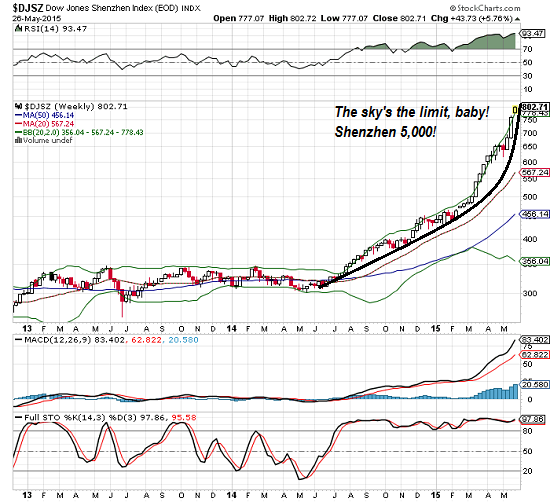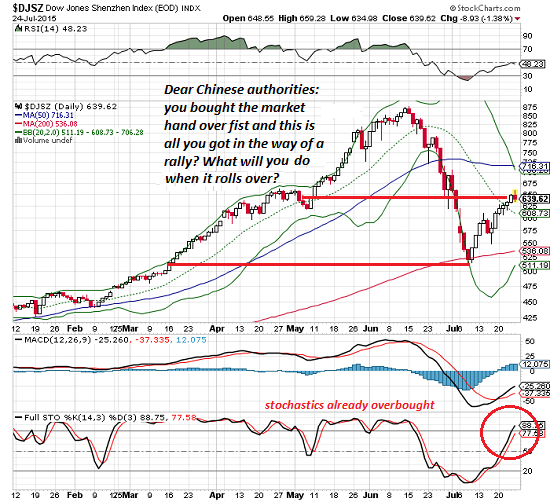Bubble, Bubble, Toil and Trouble: When Authorities Buy Assets to Prop Up Markets
The actual line from Shakespeare’s Macbeth is double, double, toil and trouble, fire burn, and cauldron bubble but for the purposes of analyzing what happens when authorities prop up market bubbles by directly buying assets, bubble, bubble, toil and trouble is also appropriate.
China’s authorities seem to have chanted Shakespeare’s magical incantation nonstop this year, as the Shenzhen and other Chinese stock market indices have more than doubled. This chart illustrates what the Chinese authorities were aiming for: a bubble that just keeps expanding and never pops:

But what actually happened was predictable: China’s stock bubble burst. In response, Chinese authorities threw everything within reach into the market to stem the decline: criminalizing negative comments about stocks, loosening credit, enablinggreater fools to post their homes as collateral for margin accounts, and the last and chillingly irreversible tool in the Central Planning Bubble Inflation Tool Kit, direct purchases of stocks: China Spends 10% Of GDP On “All Bark, No Bite” Stock Bailout:

In gambling parlance, Chinese authorities doubled-down on their bet (there’s your double, double) that they could save their bubble, bubble.
The problem is that double, double leads to bubble, bubble which leads to double trouble, because once you start down the path of buying assets to prop up bubbly markets, there is no exit.
As Sartre noted in No Exit, Hell is other people, which in the case of China’s imploding stock bubble includes all the banana vendors who are now itching to sell Centrally Planned rallies to get their borrowed money off the table before the ball drops into a slot on the roulette wheel and they lose everything.
Having accepted the poisoned chalice of buyer of last resort, Central Planners have no choice but to buy every share sold by every banana vendor who wants out.
In other markets, the sellers might be hedge funds, private equity funds, pension funds or insurance companies. But the dynamic of private sellers realizing it’s time to get out while the getting’s good is the same in all post-bubble markets.
That leaves Central Planners in a world of toil and trouble that is much like a financial Roach Motel–you can go in but you can’t get out. The Central Planning fantasy is that after buying a huge chunk of the market to stabilize the bubble, private buyers will rush back in, allowing Central Planners to distribute (sell) their shares to the credulous banana vendors, pension funds, towns in Norway still sitting on the mortgage-backed securities they bought in the previous bubble, etc.
This fantasy overlooks human psychology. A bubble is not just financial; it is a bubble of euphoria, confidence and greed. Once that bubble pops and is replaced by caution and fear, people want out–not just fickle banana vendors but professional asset managers.
Central Planners have taken on an impossible task once they become the buyer of last resort: they have to keep buying to prop up valuations, but the pool ofgreater fools willing to take the inflated shares off the central planners is shrinking.
The Central Planners can keep the market cauldron bubbling by buying assets hand over fist, but once they lower the fire of their buying, the bubbling stops and the market crashes.
The Central Planners who thought that buying shares to prop up the stock bubble was an excellent fix are about to find out the true meaning of toil and trouble. Double, double, bubble, bubble, double trouble. The magical incantation isn’t about saving markets, it’s about destroying them.
Leave a Reply